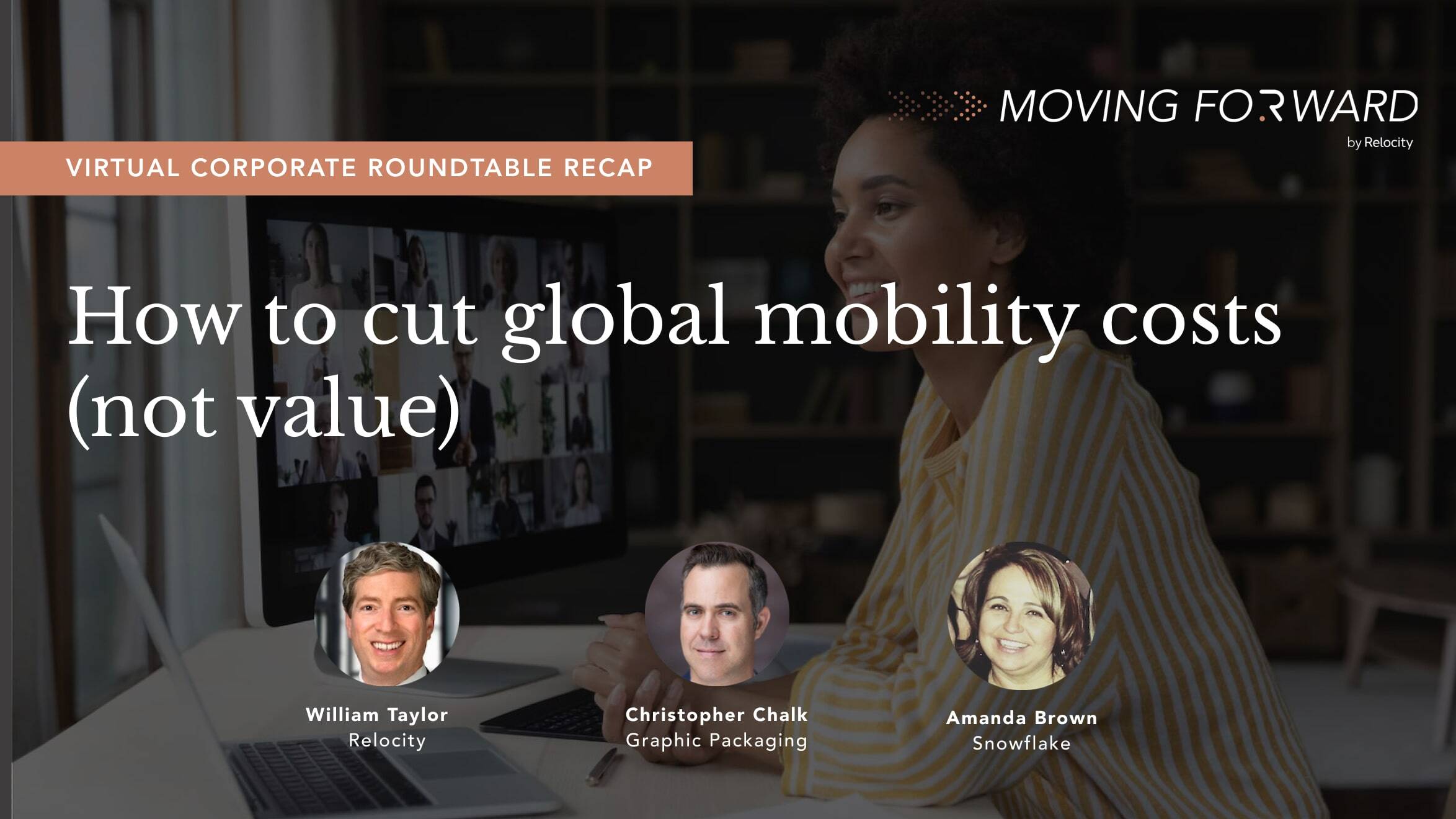[Recap] Relocity’s roundtable on ESG | Relocity
Relocity recently hosted our third virtual event as part of our corporate roundtable series: Moving Forward. These corporate roundtables bring...

Relocity recently hosted our second virtual event as part of our corporate roundtable series: Moving Forward. These corporate roundtables bring mobility professionals together to engage in open conversations and benchmarking around key topics.
On May 24, Amanda Brown, Senior Manager, Global Mobility at Snowflake, and Christopher Chalk, Global Mobility Leader at Graphic Packaging, joined Relocity’s Head of Partnerships and Moving Forward host William Taylor to discuss strategies that drive cost savings and address key trends (such as employee choice and flexibility) in the midst of today’s tough economic conditions — all while attracting and retaining top talent.

The current economic conditions are exerting downward pressure on firms to cut costs. Soaring home prices, high interest rates, and tight housing inventory are straining businesses involved in the real estate markets, while inflation, which is relatively elevated despite gradual decreases in recent months, has companies grappling with increased relocation costs. In fact, household goods shipping has become more expensive, and average total transfer costs have reached an all-time high. As a result, firms are taking proactive measures to navigate rising costs.
Brown and Chalk agreed, regardless of economic conditions, global mobility teams that can reduce costs are more effective partners within their organizations. How can you drive more value (e.g. enhance the employee experience) with less budget? Brown and Chalk shed light on the unique approaches they take to balance cost and employee experience, including tracking cost data, providing business units with cost estimates upfront (to expedite the process), educating executive teams, and conducting employee interviews. Here are 10 insights from the roundtable on cutting global mobility costs without cutting program value:

Brown shared that businesses can improve the employee experience while building out tiered policies related to managed services. Chalk agreed. “Companies must understand where jobs should truly be located to begin with, while asking questions about the right person and the right cost,” he said. Chalk also suggested doing map restructures to support employees’ location preferences after the COVID-19 pandemic.
Additionally, the last thing businesses need is a policy that’s too narrow. For example, grossing up a lump sum for a transferee with a house and kids barely covers the home sale cost. Avoid this type of situation by ensuring the relevant policy tier covers the employee’s individual needs.

Lump sums are popular in today’s environment because they support cost containment by outlining a company’s financial commitment upfront. Brown shared, “If we decide not to invest in a managed move because we can’t predict the expense, we think about low-cost/high-value additions that will improve the employee experience. Relocity has been a great partner for us in that way. Relocity makes sure our interns have the necessary relocation resources, ensuring they don't have to figure out everything on their own.”

Mobile employees have different needs. To satisfy those needs, to provide equitable support to all, and to meet rising talent expectations around employee choice, consider a core/flex policy with a built-in framework. One of our roundtable attendees commented that implementing a points-based core/flex policy wasn’t difficult, and that her firm gives each mobile employee access to a counselor who advises on necessary services.
A different attendee added that interviewing mobile employees upfront to understand which services they need makes it easy to personalize (and cost-contain) relocation support. Tailoring relocation journeys certainly drives cost savings, but isn’t feasible for small mobility teams serving hundreds of mobile employees. That’s where a reliable partner can help. Businesses can partner with other organizations to offload work to external consultants, who guide the entire relocation process.

During the roundtable, Chalk posed an excellent question, “How can I show cost savings without understanding the true cost of assignment and relocation, what my talent wants and uses, or how satisfied mobile employees are with each benefit?”
He recommended surveying mobile talent to figure out if benefits are meeting employee expectations. Taylor pointed out that employees might stop responding to surveys due to “survey fatigue,” after filling out surveys for multiple parties (including the RMC partner), a point that sparked conversation among roundtable attendees. Brown suggested that, in the event of low survey response rates, firms can conduct employee interviews to get feedback.
Chalk added that getting program insights from partners is another way to collect data. Employer dashboards provide the data insights program managers need to make decisions about mobility policies and practices.
Ultimately, data insights support cost containment by helping you understand what to continue (and stop) investing in.

One of our roundtable attendees shared the creative approach she took to get global mobility data in front of executives: inserting her own slides into the quarterly HR tax report. The data got executive attention and prompted leaders to talk to her about the program, ultimately resulting in approval to expand her team.
Chalk explained that providing leadership with key data (such as the total lifetime cost of international relocation) is much less of a manual process now, thanks to technology. Providers are reporting on cost and the status of each employee, allowing global mobility teams to become more strategic.

At a high level, global mobility adds value to organizations by supporting HR objectives like talent recruiting, engagement, development, and retention. However, measuring and demonstrating the ROI of global mobility can be difficult.
Chalk shared his perspective, “In manufacturing, for example, when we moved a General Manager, we tracked the profitability of the facility that person transferred to.” Chalk also said firms can work with each employee to determine the ROI of a move, suggesting promotion tracks can be good indicators. Mobility teams can assess whether someone who has completed an assignment will get promoted faster than someone who hasn’t.
Chalk advised against tying ROI to employee performance due to:
• The subjectivity of performance reviews. Depending on the manager’s nature, ratings can be skewed.
• The ever-changing nature of performance measurement tools.
The key performance indicators (KPIs) tied to your ROI should inform the way you strategize your program and help you determine where to invest (and where not to invest) in the mobile employee experience.

One of our roundtable attendees shared that she adjusts her approach to cost-cutting conversations based on the owner of the global mobility budget. She described the challenge of making this information readily available to managers before they make hiring decisions, “I’ve been inviting myself to a lot of meetings to share our program details and cost estimates to ensure managers understand who is responsible for the costs.”
Firms take different approaches to budget ownership. Attendees reported the following structures:
• A centralized budget within the HR/talent team.
• A dedicated budget for the global mobility team.
• Costs charged back to each business unit.
Chalk warned against processes that require approvals at every stage, regardless of budget ownership, “We used to have to get approval at every stage of assignment or relocation, which slowed us down. I sped up the process by providing each budget owner with a cost estimate upfront. I provided updates if the estimate changed along the way and let the budget owner know when costs were going to hit.”

When hiring managers and financial controllers aren’t aware of what it takes to move families across the world, the question of cost always arises. If you’re committed to setting your mobile employees up for success and helping them hit the ground running, the relocation process can be expensive, especially when it comes to the long-term costs associated with foreign national talent, like visa renewals. Chalk explained educating the leadership team on these costs is crucial. When leadership knows what they’re paying for, they better understand the impact of global mobility.
Brown offered her approach to cost-cutting conversations with leadership, “Guide leadership through these conversations by emphasizing the purpose, the need, and the thoughtfulness of moving somebody. We want to empower managers to know what mobility means.” This type of conversation helps leaders view the mobility function as a strategic partner that can help them make business decisions.
At this point in the conversation, Taylor chimed in and recommended hosting a mobility roadshow for leadership and the frequent users of relocation services. “Bringing your key suppliers and partners in helps business leaders understand what you do and why you do it. A roadshow helps demonstrate your impact on the organization,” Taylor said.
Brown added that providing her CFO with a 12-month lookback report was one of her biggest recent wins. She said, “He understood the reasoning behind each move, and I enabled him to start thinking about the team structure.”
The discussion opened to another topic: getting an executive sponsor for the global mobility team. Taylor said, “Having someone who really appreciates what you do and understands the value that you deliver not only to employees, but to the business is critical. This could be the head of talent, the head of legal, a CFO, or anyone who wants to help you build your global mobility program.”
When the mobility function has executive sponsorship (or is aligned with the executive team), they overcome cost issues easier, and cost is less of a factor altogether.

Brown pointed out that educating the leadership team might be a joint effort and shared that she partners with HR managers to present a broader view of global mobility costs. “I work with HR leadership to understand the indirect costs of global mobility, such as payroll equity benefits. Then, I create a direct cost analysis so management knows the consequences, especially for hand-raisers, of saying no to global mobility. This type of conversation gets managers at all levels interested in our function. Once they’re invested, they empower me to work with the organization’s leaders, which makes my team a more strategic partner,” she said.

Chalk shared that waiting until an employee's visa needs to be extended can be costly. Rather than being reactive to applying for a green card or extending an H-1B visa, global mobility teams should share data with each business unit that shows which employees need to repatriate each year. Questions to ask include:
• How should we replace those jobs?
• Are we going to put new people in those roles?
• Are we going to let the employees work from their home countries once they move back?
• Are we going to rotate the employees?
With this proactive approach, global mobility teams can support the talent within each business unit and reduce the overall program cost.
In conclusion, global mobility professionals can try a number of approaches to cut costs (not value).
Thanks for joining the conversation about cost savings. Stay tuned for information about our next virtual corporate roundtable about sustainability, when we’ll bring corporate mobility professionals together to talk about trends, benchmark, and learn from each other.
Book a demo to see how Relocity can help you cut mobility costs while improving your employee experience.
![[Recap] Relocity’s roundtable on ESG | Relocity](https://www.relocity.com/hubfs/Imported_Blog_Media/64a7350ce778a81576d7ba21_RTO%20Recap%20Blog%20Main%20-%20ESG-min-1.jpg)
Relocity recently hosted our third virtual event as part of our corporate roundtable series: Moving Forward. These corporate roundtables bring...

Relocity recently hosted our first virtual event as part of our corporate roundtable series: Moving Forward. Through these corporate roundtables,...
![[Recap] Relocity’s roundtable on best-in-class internship programs | Relocity](https://www.relocity.com/hubfs/Imported_Blog_Media/64f0ddbd81f00065ec04dcb5_Recap%20Blog%20Main%20-%20Internships-min-1.jpg)
As summer comes to a close, organizations are reviewing this year’s intern program performance and starting to plan for 2024 with their university...